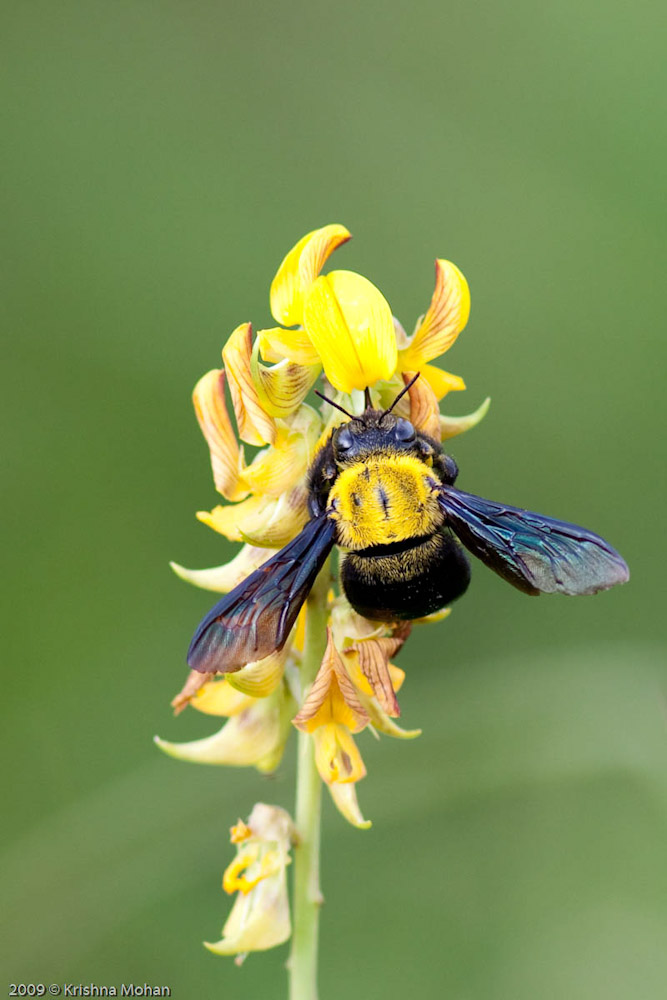
The newly acquired Canon EF 300mm f/4.0 L IS USM lens has proved great while taking fast flying insects like these carpenter bees. They don’t stop at any flower, zooming from one to another Rattleweed plants (Crotalaria retusa). Carpenter bees are known to rob nectar by slitting the sides of flowers with deep corollas. Their name comes from the fact that nearly all species build their nests in burrows in dead wood, bamboo, or structural timbers (except those in the subgenus Proxylocopa, which nest in the ground).
Carpenter bees are traditionally considered solitary bees, though some species have simple social nests in which mothers and daughters may cohabit. However, even solitary species tend to be gregarious, and often several will nest near each other. It has been occasionally reported that when females cohabit, there may be a division of labor between them, where one female may spend most of her time as a guard within the nest, motionless and near the entrance, while another female spends most of her time foraging for provisions.
Carpenter Bee nest in a tree trunk
Carpenter bees make nests by tunneling into wood, vibrating their bodies as they rasp their mandibles against the wood, each nest having a single entrance which may have many adjacent tunnels. The entrance often is a perfectly circular hole on the underside of a beam or tree limb. Carpenter bees do not eat wood. They discard the bits of wood, or re-use particles to build partitions between cells. The tunnel functions as a nursery for brood and the pollen/nectar upon which the brood subsists. The provision masses of some species are among the most complex in shape of any group of bees; whereas most bees fill their brood cells with a soupy mass, and others form simple spheroidal pollen masses, Xylocopa form elongate and carefully sculpted masses that have several projections which keep the bulk of the mass from coming into contact with the cell walls, sometimes resembling an irregular caltrop. The eggs are very large relative to the size of the female, and are some of the largest eggs among all insects.

I spotted two variety of Carpenter bees, one which was having yellow chest which is quite often confused with bumble bees. Most carpenter bees have a shiny abdomen, while in bumblebees the abdomen is completely clothed with dense hairOther was a classic blue eyed black metallic carpenter bee. These bees belong to Xylocopa Genus. I was not able to determine the exact species.


Gorgeous. Astounding insect photos in general.
Thanks Patricia for nice compliments.
I wonder how hard it must be for this guy to fly with the wing size completely out of proportion to its body. Aeronautical secrets of these insects still remains mystery.
The physics of bee flight has perplexed scientists for more than 70 years. In 1934, in fact, French entomologist August Magnan and his assistant Andr
Thank you for the info. Still science has long way to go before all the secrets of Mother nature are understood. Till then all we can do is watch in awe and wonder at these tiny miracles of nature which surrounds us.
I for one doubt science will ever unravel the secrets of mother nature. I can but hope mankind can learn to better appreciate the opportunities we are afforded to glimpse her caring touch to this planet.
We have carpenter bees similar to these here in Mountain View, CA USA. I sit here looking at her working even now. They are very friendly and inquisitive bees all in all. We drove off a woodpecker from where they have built nests for years now.
I have the same camera gear. I should attempt to get a pic of ours. I am fairly certain their eyes are black, like most of the rest of their abdomen.
Dear Richard,
Thanks for visiting and commenting on my website. Among bees I think Carpenters are the friendliest of the lot. They love to give poses to us as they are not afraid of humans in fact they are more inquisitive of us as you rightly pointed out. I would love to check out their photos. Please do let me know hen you shoot.
Regards
Krishna mohan